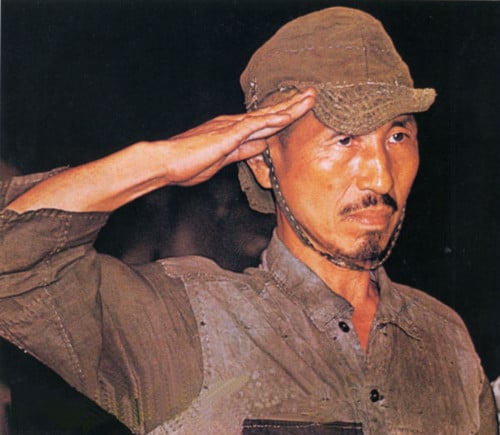
An Imperial Japanese Army officer who hid on a Philippine island refusing to surrender until 29 years after World War II ended died on Friday at age 91. Lt. Hiroo Onada had waged a guerilla campaign against villagers on the island of Lubang, ignoring pleas from Japanese officials and family members to lay down his arms. It took a March 9, 1974, face-to-face meeting with his former commander, Major Yoshimi Taniguchi, at a remote location on the island to convince Onada that the war was over.
Onada had been trained as an intelligence officer and guerrilla tactics coach before arriving on Lubang in 1944 with orders never to surrender, never to resort to suicide attacks, and to hold out until reinforcements arrived. He and three soldiers diligently obeyed the commands after Japan officially surrendered to the Allies on Sept. 2, 1945.
The four men kept busy surveying military facilities, attacking local residents, and sometimes clashing with Philippine troops. For food, they trapped game and birds, stole rice and fruit, and occasionally killed villagers’ cows and made dried beef.
One of the men emerged and returned to Japan in 1950, and another, Corporal Shoichi Shimada, was shot in killed by a search party in May 1954. The last of Onada’s comrades, Private First Class Kinshichi Kozuka, died in October 1972 as a result of a shootout with local troops. Less than two years later, after cautiously arriving for his meeting with Taniguchi, who had since become a bookseller, the lieutenant received orders from his old commander to “cease all combat activities and operations immediately.”
In his memoir, No Surrender: My Thirty-Year War (Naval Institute Press, 1999), Onada recalled that he was skeptical to the end: “I stood still, waiting for what was to follow. I felt sure Major Taniguchi would come up to me and whisper, ‘That was so much talk. I will tell you your real orders later.’ . . . Major Taniguchi slowly folded up the order and for the first time I realized that no subterfuge was involved. This was no trick—everything I had heard was real. . . . We really lost the war! How could they have been so sloppy? Suddenly everything went black.”
Wearing his 30-year-old uniform, Onada surrendered to Philippine President Ferdinand Marcos before setting off for Japan, where he received a hero’s welcome. He was one of the last of many so-called Japanese “holdouts,” servicemen scattered around the Pacific who refused to surrender and came to symbolize Japan’s wartime perseverance and devotion to Emperor Hirohito.
Later in life Onada lived in Brazil, where he raised cattle, and since 1984 he had organized Onada Nature School, which provided nature and life education in Japan.
In a 1995 interview with the Associated Press, he said: “I don’t consider those 30 years a waste of time. Without that experience I wouldn’t have my life today.”





